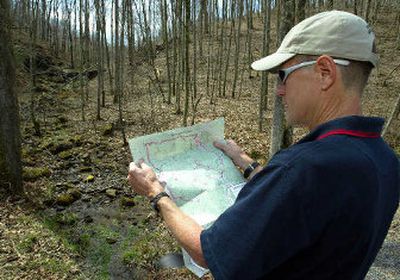Difficult course

WARTBURG, Tenn. – A failed escape into East Tennessee’s mountainous terrain by convicted assassin James Earl Ray in June 1977 gave Gary Cantrell an idea for a race that has become known as one of the world’s hardest ultramarathons.
Set on an unmarked, rugged course through briar-infested woods, the Barkley Marathon is so difficult some runners don’t consider it a real race.
Only six people have finished the entire 100-mile journey – five times around a 20-mile loop in Frozen Head State Park – in the allotted time of 60 hours.
Other participants choose the “fun run” of 60 miles, or three loops, in 40 hours. Most people are just happy completing one loop.
Ray, the confessed killer of Martin Luther King Jr., was captured 55 hours after his escape only 8 miles east of Brushy Mountain State Penitentiary, which is bordered by steep hillsides and the state park.
“In that length of time, I could have made 100 miles,” Cantrell, a long-distance runner and hiker, recalls saying back then.
“It turns out it’s not that easy.”
Run since 1986, the Barkley has drawn the likes of athletes who hold speed records for the Appalachian and Pacific Crest trails and made hobbies of running 100-milers such as the Western States Endurance Run in California, Hardrock 100 in Colorado and the Badwater Ultramarathon starting in Death Valley.
And then they find out why the Barkley has become known as “the race that eats its young.”
“We do things that most people think are impossible,” said 58-year-old Ed Furtaw, who recently ran in his 10th Barkley and was the first person to finish the “fun run” in 1988. “This event needs to exist. Otherwise, people won’t know what they can take.”
This year’s race began, appropriately enough, on April Fools’ Day and again had no 100-mile finishers.
Only two participants out of 33 – Nick Gracie from England and Brian Robinson from California – finished the “fun run”, but they came in a few minutes over the 40-hour limit and were not allowed to continue for a chance at the 100.
Temperatures near 80 on the first day made it difficult for the runners to stay hydrated, and only 22 completed the first loop. Five finished two loops.
Four hours and 34 minutes into the race, the first four racers emerged from the woods, crossed a curvy highway and hustled up a hill beside a small waterfall. Jim Nelson, who completed the 100 in 2004, had bloody cuts all over his legs.
About 30 minutes later they crossed the road in another place and climbed a steeper embankment overlooking the old prison in Petros, where Ray made his daring escape.
The Barkley course starts in a campground in the park in Wartburg, about 40 miles west of Knoxville in the Cumberland Mountains.
Racers might run in a few spots on the Barkley. Crawling and sliding is acceptable. Much of the course is up and down steep hills. The entire 100 miles would total 100,000 feet of elevation change, the equivalent of climbing and descending Mount McKinley two and a half times. McKinley, the tallest peak in North America, is 20,320 feet.
Cantrell signals the start of the race by lighting a cigarette. The racers – only 35 are allowed each year – start making their way with a topography map, compass and detailed instructions to find the intended path, which often is overgrown with briars and downed trees. It gets really tricky in the dark, even with flashlights.
Unlike other ultramarathons, there is no aid except two water drops. If a person quits, he has to walk back to the start, where “Taps” is played on a bugle.
“What we’re doing is kind of absurd,” Furtaw said. “We’re crazy, and we know it.”